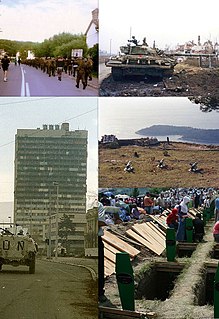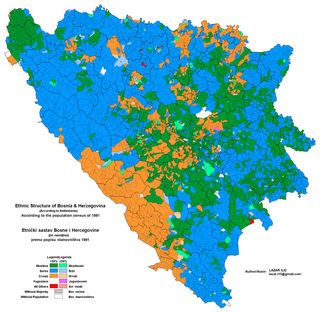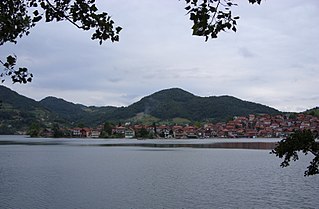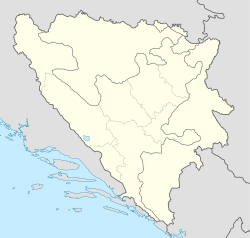
Srebrenica is a town and municipality located in the easternmost part of Republika Srpska, an entity of Bosnia and Herzegovina. It is a small mountain town, with its main industry being salt mining and a nearby spa. As of 2013, the town has a population of 2,607 inhabitants, while the municipality has 13,409 inhabitants.

Naser Orić is a former Bosnian military officer and accused war criminal who commanded Army of the Republic of Bosnia and Herzegovina (ARBiH) forces in the Srebrenica enclave in eastern Bosnia surrounded by Bosnian Serb forces, during the Bosnian War.

Foča is a town and a municipality located in Republika Srpska in south-eastern Bosnia and Herzegovina, on the banks of Drina river. As of 2013, the town has a population of 12,234 inhabitants, while the municipality has 18,288 inhabitants.

The Yugoslav Wars were a series of separate but related ethnic conflicts, wars of independence, and insurgencies fought in the former Yugoslavia from 1991 to 2001, leading up to and resulting from the breakup of the Yugoslav federation in 1992. Its constituent republics declared independence due to unresolved tensions between ethnic minorities in the new countries, which fueled the wars.

The Bosnian War was an international armed conflict that took place in Bosnia and Herzegovina between 1992 and 1995. The war is commonly seen as having started on 6 April 1992, following a number of earlier violent incidents. The war ended on 14 December 1995. The main belligerents were the forces of the Republic of Bosnia and Herzegovina and those of Herzeg-Bosnia and Republika Srpska, proto-states led and supplied by Croatia and Serbia, respectively.

The Bosnian genocide refers to either the Srebrenica massacre or the wider crimes against humanity and ethnic cleansing campaign throughout areas controlled by the Army of Republika Srpska (VRS) during the Bosnian War of 1992–1995. The events in Srebrenica in 1995 included the killing of more than 8,000 Bosniak men and boys, as well as the mass expulsion of another 25,000–30,000 Bosniak civilians by VRS units under the command of General Ratko Mladić.

This article is about the Demographic history of Bosnia and Herzegovina, and deals with the country's documented demographics over time. For an overview of the various ethnic groups and their historical development, see Ethnic groups in Bosnia and Herzegovina.

The 1991 population census in Bosnia and Herzegovina was the last census of the population undertaken in the Socialist Republic of Bosnia and Herzegovina before the Bosnian War. It was conducted during the final week of March 1991. For the 1991 census there were 109 municipalities of which ten were part of Sarajevo.

The Ahmići massacre was the murder of approximately 120 Bosniak civilians by members of the Croatian Defence Council in April 1993, during the Croat–Bosniak War. The massacre was the culmination of the Lašva Valley ethnic cleansing committed by the political and military leadership of the Croatian Community of Herzeg-Bosnia. It was the largest massacre committed during the conflict between Bosnian Croats and the Bosniak-dominated Bosnian government.

There was a campaign of ethnic cleansing in the area of the town of Foča committed by Serb military, police, and paramilitary forces on Bosniak civilians from 7 April 1992 to January 1994 during the Bosnian War. By one estimate, around 21,000 non-Serbs left Foča after July 1992.

The Croat–Bosniak War was a conflict between the Republic of Bosnia and Herzegovina and the self-proclaimed Croatian Republic of Herzeg-Bosnia, supported by Croatia, that lasted from 18 October 1992 to 23 February 1994. It is often referred to as a "war within a war" because it was part of the larger Bosnian War. In the beginning, Bosniaks and Croats fought in an alliance against the Yugoslav People's Army (JNA) and the Army of Republika Srpska (VRS). By the end of 1992, however, tensions between Bosniaks and Croats increased. The first armed incidents between them occurred in October 1992 in central Bosnia. Their military alliance held out until early 1993 when their cooperation fell apart and the two former allies engaged in open conflict.

The Siege of Srebrenica was a three-year siege of the town of Srebrenica in eastern Bosnia and Herzegovina which lasted from April 1992 to July 1995 during the Bosnian War. Initially assaulted by the Yugoslav People's Army (JNA) and the Serbian Volunteer Guard (SDG), the town was encircled by the Army of Republika Srpska (VRS) in May 1992, starting a brutal siege which was to last for the majority of the Bosnian War. In June 1995, the commander of the Army of the Republic of Bosnia and Herzegovina (ARBiH) in the enclave, Naser Orić, left Srebrenica and fled to the town of Tuzla. He was subsequently replaced by his deputy, Major Ramiz Bećirović.

Divič is a village by the city of Zvornik, Bosnia and Herzegovina. It is located on the Drina River, by an artificial lake created to form a reservoir for the HPP Zvornik hydro-electric power plant. The Drina River and the lake are a natural and administrative border between Bosnia and Herzegovina and Serbia and during the international armed conflict of 1992–95 the village was "ethnically cleansed" of its Bosniak inhabitants by Serb forces.

The Croat–Bosniak War was a conflict between the Republic of Bosnia and Herzegovina and the Croatian Community of Herzeg-Bosnia, supported by Croatia, that lasted from 19 June 1992 – 23 February 1994. The Croat-Bosniak War is often referred to as a "war within a war" because it was part of the larger Bosnian War.

Dragočaj is a village in the municipality of Banja Luka, Republika Srpska, Bosnia and Herzegovina.

The Zvornik massacre refers to acts of mass murder and violence committed against Bosniaks and other non-Serb civilians in Zvornik by Serb paramilitary groups at the beginning of the Bosnian War in 1992. It was part of a wider campaign of ethnic cleansing in the Bosnian War: by one estimate, 40,000 Bosniaks were expelled from the Zvornik district.

Kupusovići is a village in the municipality of Višegrad, Bosnia and Herzegovina.

Ethnic cleansing occurred during the Bosnian War (1992–95) as large numbers of Bosnian Muslims (Bosniaks) and Bosnian Croats were forced to flee their homes or were expelled by the Army of Republika Srpska and Serb paramilitaries. Bosniaks and Bosnian Serbs had also been forced to flee or were expelled by Bosnian Croat forces, though on a restricted scale and in lesser numbers. The UN Security Council Final Report (1994) states while Bosniaks also engaged in "grave breaches of the Geneva Conventions and other violations of international humanitarian law", they did not engage in "systematic ethnic cleansing" to the same degree as Bosnian Serb forces. According to the report, "there is no factual basis for arguing that there is a 'moral equivalence' between the warring factions".
The RAM Plan, also known as Operation RAM, Brana Plan, or Rampart-91, was a military plan developed over the course of 1990 and finalized in Belgrade, Serbia, during a military strategy meeting in August 1991 by a group of senior Serb officers of the Yugoslav People's Army (JNA) and experts from the JNA's Psychological Operations Department. Its purpose was organizing Serbs outside Serbia, consolidating control of the Serbian Democratic Parties (SDS), and preparing arms and ammunition in an effort of establishing a country where "all Serbs with their territories would live together in the same state." A separate group of undercover operatives and military officers was charged with the implementation of the plan. These people then undertook numerous actions during the Yugoslav Wars that were later described as ethnic cleansing, extermination and genocide.

The Bradina massacre is the mass murder of at least 48 Bosnian Serb civilians by joint Bosniak and Bosnian Croatian forces on May 25, 1992 in the village of Bradina, located in the municipality of Konjic, during the Bosnian war.


















